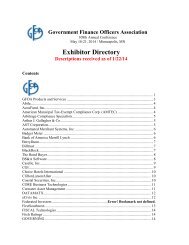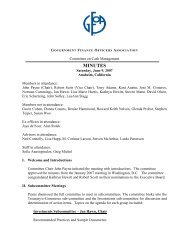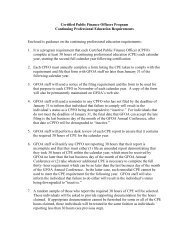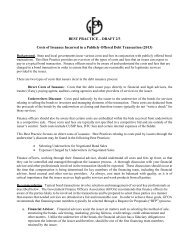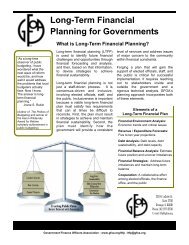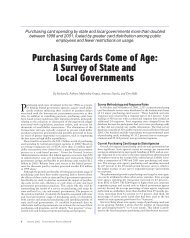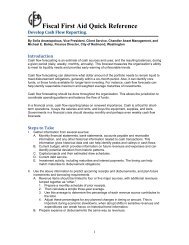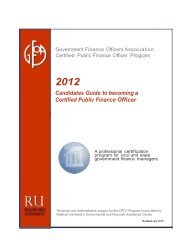Editor's note - Government Finance Officers Association
Editor's note - Government Finance Officers Association
Editor's note - Government Finance Officers Association
You also want an ePaper? Increase the reach of your titles
YUMPU automatically turns print PDFs into web optimized ePapers that Google loves.
Editor’s <strong>note</strong>: This article is adapted from a new GFOA publication,<br />
Cost Analysis and Activity-Based Costing for <strong>Government</strong>.<br />
In this period of tight budgets, many governments are under<br />
increasing pressure to do more with less. One potential way to<br />
reduce costs is to outsource services to private firms, non-profit<br />
organizations, or other governments that can provide the services<br />
more efficiently. In some cases, outsourcing can result in significant<br />
cost savings over the long run. In other cases, however, outsourcing<br />
may actually end up increasing a government’s total costs. How can<br />
a government know whether outsourcing a given service will result<br />
in a cost savings or a cost increase? This article answers this question<br />
by demonstrating how to perform a cost analysis.<br />
The decision as to whether to perform a service “in house” or<br />
outsource it to an external provider is commonly referred to as the<br />
“make-versus-buy” decision. This article walks through the steps<br />
involved in a make-versus-buy cost analysis. But first, two key<br />
points warrant emphasis: (1) a make-versus-buy cost analysis<br />
should use a differential cost perspective and (2) the analysis<br />
should cover a multi-year period and discount future cash flows to<br />
their present value.<br />
USE A DIFFERENTIAL COST PERSPECTIVE<br />
Differential cost is the key cost concept for evaluating the outsourcing<br />
of a service. The differential cost shows how a decision to<br />
outsource will change a government's costs. It is crucial to look at<br />
the differential costs instead of merely comparing the total costs of<br />
the status quo to the total costs of using a private contractor. The<br />
pitfall of comparing total costs is that they may include fixed costs<br />
that cannot be avoided by outsourcing a service. This could give<br />
the appearance that a government will incur fewer costs by using<br />
a private contractor when it actually will incur more. 1<br />
For example, let’s say that a private waste hauler offers to provide<br />
waste collection services to the City of Unionsville for<br />
$550,000 per year. As it stands, the total cost of providing waste<br />
collection services is $750,000 per year. Thus, it appears that the<br />
city could save $200,000 per year by hiring the private hauler.<br />
However, a closer look at the city's fixed costs reveals that it is<br />
committed to spending much of the $750,000 whether or not it<br />
switches to a private hauler. More than half of this amount is personnel<br />
costs, which the city cannot avoid because of a “no-layoff”<br />
policy and the fact that the truck drivers perform other responsibilities.<br />
Likewise, the city is committed to $50,000 per year in debt<br />
service payments for the facilities used to store and maintain its<br />
garbage trucks.<br />
Sunk costs. A potential mistake in a make-versus-buy cost analysis<br />
is the inclusion of sunk costs. A sunk cost is a cost that has already<br />
occurred and will remain the same regardless of what decision is<br />
made. As such, sunk costs should be ignored in a cost analysis.<br />
To see how including sunk costs can lead to bad decisions,<br />
suppose a county government is considering outsourcing its<br />
warehouse function to private suppliers that can maintain inventories<br />
of all the county's supplies and ship them overnight. One<br />
year earlier, the county had spent $500,000 for a consultant to<br />
develop a state-of-the-art inventory process. Opponents of the<br />
outsourcing plan argue that the county should not outsource the<br />
warehouse function because it just poured $500,000 into perfecting<br />
the existing system. However, this $500,000 should not influence<br />
the decision because it cannot be recovered regardless of<br />
the course of action the county takes; only the differential cost of<br />
the two alternatives should influence the decision. If the differential<br />
cost of outsourcing the warehouse function is $340,000 less<br />
per year than retaining this function in-house, including the sunk<br />
cost of the consulting services would lead the county to spend<br />
$340,000 per year more than it has to.<br />
Opportunity costs. Another important cost concept in makeversus-buy<br />
decisions is opportunity cost. Opportunity cost is the<br />
lost opportunity of using an asset or resource in a way other than<br />
the chosen alternative. For example, if a suburban government<br />
sells a public swimming pool to a private company to own and<br />
operate, the opportunity cost would include the admittance fee<br />
revenue that would have been collected if the pool remained a<br />
public asset. Likewise, the opportunity cost of not selling the pool<br />
would be the revenue from the sale of the pool.<br />
COVER A MULTI-YEAR PERIOD AND DISCOUNT<br />
FUTURE CASH FLOWS<br />
A cost comparison should cover a multi-year period. This is<br />
important for two reasons. First, a multi-year analysis is more<br />
likely to reveal whether outsourcing will generate long-term savings.<br />
A government should experience much of the cost savings<br />
related to outsourcing in later years, as leases and contracts<br />
expire and fixed costs become variable costs. Second, a multiyear<br />
contract is usually more attractive to potential vendors,<br />
which creates more competition and drives down the costs of<br />
the contract.<br />
In a multi-year analysis, future cash flows should be discounted<br />
to their present value. This ensures that appropriate weight is given<br />
to future costs and benefits. Discounting is the process of converting<br />
a future value into its present value. 2<br />
16 <strong>Government</strong> <strong>Finance</strong> Review | August 2004



